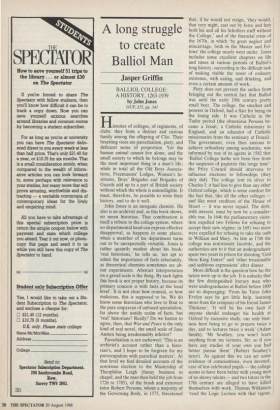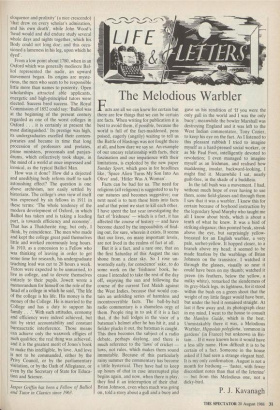A long struggle to create
Balliol Man
Jasper Griffin
BALLIOL COLLEGE: A HISTORY, 1263-1939 by John Jones OUP, f35, pp. 343 Histories of colleges, of regiments, of clubs: they form a distinct and curious family among the offspring of Clio. Their besetting vices are parochialism, piety, and deficient sense of proportion. Yet the human animal cannot live alone, and the small society to which he belongs may be the most important thing in a man's life; while in total all the Old Boys Associa- tions, Freemasons' Lodges, Women's In- stitutes, Boys' Brigades and Brigades of Guards add up to a part of British society without which the whole is unintelligible. It must, therefore, be possible to write their history, and to do it well.
John Jones is an inorganic chemist. He also is an archivist and, as this book shows, no mean historian. That combination is itself a tribute to the college system, where no departmental head can express effective disapproval, as happens in some places, when a member of his department turns out to be unexpectedly versatile. Jones is rather quaintly modest about his book: `real historians,' he tells us, `are apt to admit the importance of facts reluctantly, as theoretical chemists sometimes are ab- out experiments. Abstract interpretation on a grand scale is the thing. By such lights this book is not proper history, because its primary concern is with facts at the local level'. It is not clear how ironical, or how malicious, this is supposed to be. We do know some historians who love to float in the pure empyrean of unbased speculation, far above the untidy realm of facts, but `real' historians? Really? Do we hasten to agree, then, that War and Peace is the only kind of real novel, the small scale of Jane Austen being irredeemably inferior?
Parochialism is not eschewed: 'This is an archivist's account rather than a histo- rian's, and I hope to be forgiven for my preoccupation with parochial matters'. At that level we find detailed accounts of the notorious election to the Mastership of Theophilus Leigh (funny business in chapel, and the man then held the job from 1726 to 1785), of the brash and extrovert tutor Robert Persons, whom a majority of the Governing Body, in 1573, threatened that, if he would not resign, `they would, that very night, cast out by force and fury both his and all his Schollers stuff without the College,' and of the financial crisis of the 1670s, in which `by great neglect and miscarriage, both in the Master and Fel- lows' the college nearly went under. Jones includes some excellent chapters on life and times at various periods of Balliol's long history, succeeding in the difficult task of making visible the tenor of ordinary existence, with eating, and drinking, and even a certain amount of work.
Piety does not prevent the author from bringing out the central fact that Balliol was until the early 19th century pretty small beer. The college, the smallest and poorest in Oxford, had a flair for being on the losing side. It was Catholic in the Tudor period (the obnoxious Persons be- came a Jesuit, a Catholic missionary in England, and an educator of Catholic missionaries from the seminary at Douai). The government, even then anxious to achieve orthodoxy among academics, was informed by one of its agents in 1582 that `Bank)! College hathe not been free from the suspicion of papistrie this longe time': the Privy Council should intervene to influence elections to fellowships (they duly did). The college lent its silver to Charles I: it had less to give than any other Oxford college, which is some comfort for the fact that, like all the other colleges and like most creditors of the House of Stuart — it was never repaid. The debt, with interest, must by now be a consider- able one. In 1646 the parliamentary visita- tion expelled two Fellows for refusing to accept their new regime; in 1691 two more were expelled for refusing to take the oath to William and Mary. As late as 1748 the college was notoriously Jacobite, and the authorities saw to it that an undergraduate spent two years in prison for shouting 'God bless King James!' and 'other treasonable and seditious expressions' after dinner.
More difficult is the question how far the tutors were up to the job. It is unlucky that the few distinguished literary men who were undergraduates at Balliol before 1800 are so disparaging: `From his Tutor John Evelyn says he got little help, learning more from the company of his friend James Thickens'; 'It will be his own fault if anyone should endanger his health at Oxford by excessive study, our only busi- ness here being to go to prayers twice a day, and to lectures twice a week' (Adam Smith); `Mr Southey, you won't learn anything from my lectures, Sir; so if you have any studies of your own you had better pursue them' (Robert Southey's tutor). As against this we can set some evidence of conscientious, even devoted, care of less celebrated pupils — the college seems to have been better with young men of no showy talents — and two tutors in the 17th century are alleged to have killed themselves with work. Thomas Wilkinson 'read the Logic Lecture with that vigour, eloquence and prolixity' (a nice crescendo) `that drew on every scholar's admiration, and his own death', while John Wood's `head would and did endure study several whole days and nights together, which his Body could not long doe; and this occa- sioned a lameness in his leg, upon which he dyed'.
From a low point about 1780, when in an Oxford which was generally mediocre Bal- liol represented the nadir, an upward movement began. Its origins are myste- rious, the men who seem to be responsible little more than names to posterity. Open scholarships attracted able applicants, energetic and high-principled tutors were elected. Success bred success. The Royal Commission of 1852 could say: `Balliol was at the beginning of the present century regarded as one of the worst colleges in Oxford . . . it is certainly at present the most distinguished.' Its prestige was high, its undergraduates excelled their contem- poraries and became in time that long procession of professors and prelates, prime ministers, proconsuls and panjan- drums, which collectively took shape, in the mind of a world at once impressed and ironical, as the typical Balliol Man.
How was it done? How did a dejected and unedifying body reform itself to such astonishing effect? The question is one above archivism, nor easily settled by historians. The college's own view of itself was expressed by six fellows in 1911 in these terms: 'The whole tendency of the modern development of Oxford, in which Balliol has taken and is taking a leading part, is towards efficiency and economy'. That has a Thatcherite ring; but only, I think, by coincidence. The men who made and kept the college great paid themselves little and worked enormously long hours. In 1910, as a concession to a Fellow who was thinking of leaving in order to get some time for research, his undergraduate teaching load was cut to 20 hours a week. Tutors were expected to be unmarried, to live in college, and to devote themselves entirely to their pupils. Jowett wrote a memorandum for himself on the role of the head of a college in which he said, 'The life of the college is his life. His money is the money of the College. He is married to the College and has a duty to support his family . . .'. With such attitudes, economy and efficiency were indeed achieved, but not by strict accountability and constant bureaucratic interference. Those means can achieve only the waxwork effigies of such qualities; the real thing was achieved, and it is the greatest merit of Jones's book to make this intelligible, by love. And love is not to be commanded, either by the Privy Council, or by the parliamentary visitation, or by the Oath of Allegiance, or even by the Secretary of State for Educa- tion and Science.
Jasper Griffin has been a Fellow of Balliol and Tutor in Classics since 1963.























































 Previous page
Previous page